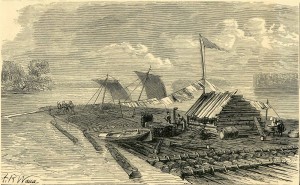
Sketch of an early flatboat or raft with living quarters for humans and space for livestock. Many of these floated pioneers to new lands at very little cost. Note the woman washing clothes to the right. Life carried on whether on water or land.
From early colonial times, land along navigable waterways was considered extremely valuable. This riparian farmland was usually fertile, well watered and with the adjacent river goods could be taken to market much cheaper than overland. With the opening of the West between the Appalachian Mountains and the Mississippi River, the major transportation routes were down the Ohio River to the Mississippi to the port of New Orleans. While a much longer journey, it was cheaper than building roads over the mountains.
By the early 1800, Tennesseans crafted houseboats and floated their way down the Mississippi to new lands. The Wright family of Lamar County arrived after a six-month trip down the Mississippi to the mouth of the Red River and up that river to Pecan Point in present-day Red River County. It was a long and arduous trek, with swamps and mosquitos, but all arrived safely. The area around what is today Shreveport was especially hazardous with the Red River Raft or logjam.
Charles Fenton Mercer advertised that the Trinity River was navigable to Dallas in an effort to sell land in the Mercer Colony in 1845. Unfortunately, that was false advertising to say the least. By the 1890s, one small snag boat made it to the Oak Cliff area. The water was too shallow and the roots, logs, and other debris made the trek dangerous.
Recently I found a letter from a woman in East Texas to relatives in Fort Worth written in the 1920s. While the relationships were blurred to say the least, she included a most interesting story. It took place in Panola County, on the extreme eastern border of Texas with Louisiana. Panola County, like Hunt County, was created in 1846, having been part of Shelby and Harrison Counties during the Republic of Texas. The major village at the time was Pulaski, located on the banks of the Sabine River.
Shortly after the 1850 Federal Census S. L. Davis decided to move his family to the town of Orange, the southeastern most community in Texas. Davis hired a carpenter to build the family a houseboat with four rooms. When the Sabine was “on the rise” it was floated on the river. Mr. Davis loaded his favorite cow to furnish milk, a couple of horses, pen of chickens, and other animals on the houseboat along with the family belongings. The family then set off on their journey. At night they tied the boat to the shore, hobbled or staked the animals for grazing, and went back to the boat to sleep. Each morning after the animals were retrieved, the journey began anew. The only haphazard on the trip, according to the author, was the loss of a locket belonging to one of the young daughters.
Once they arrived in Orange, Davis sold the houseboat for lumber, and found a landlocked home for the family. However, Davis did not particularly enjoy or maybe didn’t do well in business in Orange for by the 1860 Federal Census they were back in the Panola County seat of Carthage where Mr. and Mrs. Davis operated the only hotel in town. Ironically, the daughter who lost her locket in the muddy Sabine River later married the builder of the houseboat. However, I don’t believe they tried that adventure again.
